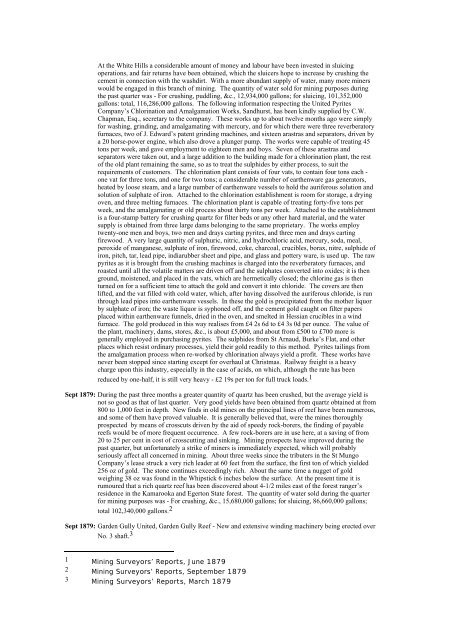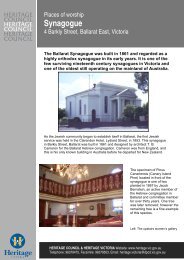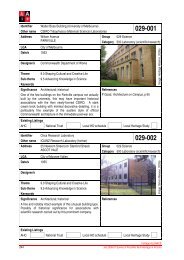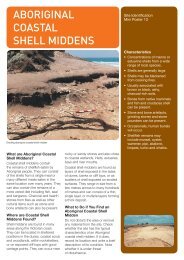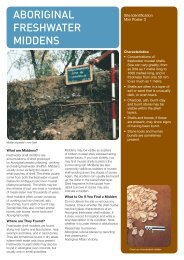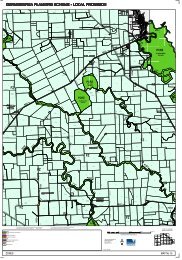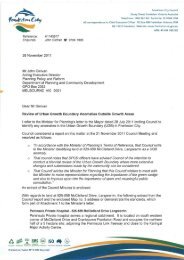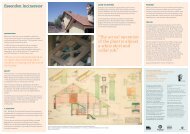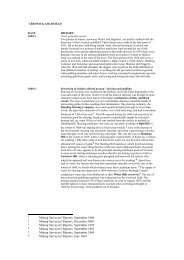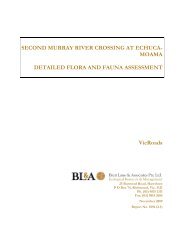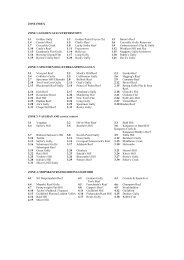Bendigo General History - Department of Planning and Community ...
Bendigo General History - Department of Planning and Community ...
Bendigo General History - Department of Planning and Community ...
You also want an ePaper? Increase the reach of your titles
YUMPU automatically turns print PDFs into web optimized ePapers that Google loves.
At the White Hills a considerable amount <strong>of</strong> money <strong>and</strong> labour have been invested in sluicing<br />
operations, <strong>and</strong> fair returns have been obtained, which the sluicers hope to increase by crushing the<br />
cement in connection with the washdirt. With a more abundant supply <strong>of</strong> water, many more miners<br />
would be engaged in this branch <strong>of</strong> mining. The quantity <strong>of</strong> water sold for mining purposes during<br />
the past quarter was - For crushing, puddling, &c., 12,934,000 gallons; for sluicing, 101,352,000<br />
gallons: total, 116,286,000 gallons. The following information respecting the United Pyrites<br />
Company’s Chlorination <strong>and</strong> Amalgamation Works, S<strong>and</strong>hurst, has been kindly supplied by C.W.<br />
Chapman, Esq., secretary to the company. These works up to about twelve months ago were simply<br />
for washing, grinding, <strong>and</strong> amalgamating with mercury, <strong>and</strong> for which there were three reverberatory<br />
furnaces, two <strong>of</strong> J. Edward’s patent grinding machines, <strong>and</strong> sixteen arastras <strong>and</strong> separators, driven by<br />
a 20 horse-power engine, which also drove a plunger pump. The works were capable <strong>of</strong> treating 45<br />
tons per week, <strong>and</strong> gave employment to eighteen men <strong>and</strong> boys. Seven <strong>of</strong> these arastras <strong>and</strong><br />
separators were taken out, <strong>and</strong> a large addition to the building made for a chlorination plant, the rest<br />
<strong>of</strong> the old plant remaining the same, so as to treat the sulphides by either process, to suit the<br />
requirements <strong>of</strong> customers. The chlorination plant consists <strong>of</strong> four vats, to contain four tons each -<br />
one vat for three tons, <strong>and</strong> one for two tons; a considerable number <strong>of</strong> earthenware gas generators,<br />
heated by loose steam, <strong>and</strong> a large number <strong>of</strong> earthenware vessels to hold the auriferous solution <strong>and</strong><br />
solution <strong>of</strong> sulphate <strong>of</strong> iron. Attached to the chlorination establishment is room for storage, a drying<br />
oven, <strong>and</strong> three melting furnaces. The chlorination plant is capable <strong>of</strong> treating forty-five tons per<br />
week, <strong>and</strong> the amalgamating or old process about thirty tons per week. Attached to the establishment<br />
is a four-stamp battery for crushing quartz for filter beds or any other hard material, <strong>and</strong> the water<br />
supply is obtained from three large dams belonging to the same proprietary. The works employ<br />
twenty-one men <strong>and</strong> boys, two men <strong>and</strong> drays carting pyrites, <strong>and</strong> three men <strong>and</strong> drays carting<br />
firewood. A very large quantity <strong>of</strong> sulphuric, nitric, <strong>and</strong> hydrochloric acid, mercury, soda, meal,<br />
peroxide <strong>of</strong> manganese, sulphate <strong>of</strong> iron, firewood, coke, charcoal, crucibles, borax, nitre, sulphide <strong>of</strong><br />
iron, pitch, tar, lead pipe, indiarubber sheet <strong>and</strong> pipe, <strong>and</strong> glass <strong>and</strong> pottery ware, is used up. The raw<br />
pyrites as it is brought from the crushing machines is charged into the reverberatory furnaces, <strong>and</strong><br />
roasted until all the volatile matters are driven <strong>of</strong>f <strong>and</strong> the sulphates converted into oxides; it is then<br />
ground, moistened, <strong>and</strong> placed in the vats, which are hermetically closed; the chlorine gas is then<br />
turned on for a sufficient time to attach the gold <strong>and</strong> convert it into chloride. The covers are then<br />
lifted, <strong>and</strong> the vat filled with cold water, which, after having dissolved the auriferous chloride, is run<br />
through lead pipes into earthenware vessels. In these the gold is precipitated from the mother liquor<br />
by sulphate <strong>of</strong> iron; the waste liquor is syphoned <strong>of</strong>f, <strong>and</strong> the cement gold caught on filter papers<br />
placed within earthenware funnels, dried in the oven, <strong>and</strong> smelted in Hessian crucibles in a wind<br />
furnace. The gold produced in this way realises from £4 2s 6d to £4 3s 0d per ounce. The value <strong>of</strong><br />
the plant, machinery, dams, stores, &c., is about £5,000, <strong>and</strong> about from £500 to £700 more is<br />
generally employed in purchasing pyrites. The sulphides from St Arnaud, Burke’s Flat, <strong>and</strong> other<br />
places which resist ordinary processes, yield their gold readily to this method. Pyrites tailings from<br />
the amalgamation process when re-worked by chlorination always yield a pr<strong>of</strong>it. These works have<br />
never been stopped since starting except for overhaul at Christmas. Railway freight is a heavy<br />
charge upon this industry, especially in the case <strong>of</strong> acids, on which, although the rate has been<br />
reduced by one-half, it is still very heavy - £2 19s per ton for full truck loads. 1<br />
Sept 1879: During the past three months a greater quantity <strong>of</strong> quartz has been crushed, but the average yield is<br />
not so good as that <strong>of</strong> last quarter. Very good yields have been obtained from quartz obtained at from<br />
800 to 1,000 feet in depth. New finds in old mines on the principal lines <strong>of</strong> reef have been numerous,<br />
<strong>and</strong> some <strong>of</strong> them have proved valuable. It is generally believed that, were the mines thoroughly<br />
prospected by means <strong>of</strong> crosscuts driven by the aid <strong>of</strong> speedy rock-borers, the finding <strong>of</strong> payable<br />
reefs would be <strong>of</strong> more frequent occurrence. A few rock-borers are in use here, at a saving <strong>of</strong> from<br />
20 to 25 per cent in cost <strong>of</strong> crosscutting <strong>and</strong> sinking. Mining prospects have improved during the<br />
past quarter, but unfortunately a strike <strong>of</strong> miners is immediately expected, which will probably<br />
seriously affect all concerned in mining. About three weeks since the tributers in the St Mungo<br />
Company’s lease struck a very rich leader at 60 feet from the surface, the first ton <strong>of</strong> which yielded<br />
256 oz <strong>of</strong> gold. The stone continues exceedingly rich. About the same time a nugget <strong>of</strong> gold<br />
weighing 38 oz was found in the Whipstick 6 inches below the surface. At the present time it is<br />
rumoured that a rich quartz reef has been discovered about 4-1/2 miles east <strong>of</strong> the forest ranger’s<br />
residence in the Kamarooka <strong>and</strong> Egerton State forest. The quantity <strong>of</strong> water sold during the quarter<br />
for mining purposes was - For crushing, &c., 15,680,000 gallons; for sluicing, 86,660,000 gallons;<br />
total 102,340,000 gallons. 2<br />
Sept 1879: Garden Gully United, Garden Gully Reef - New <strong>and</strong> extensive winding machinery being erected over<br />
No. 3 shaft. 3<br />
1 Mining Surveyors’ Reports, June 1879<br />
2 Mining Surveyors’ Reports, September 1879<br />
3 Mining Surveyors’ Reports, March 1879


